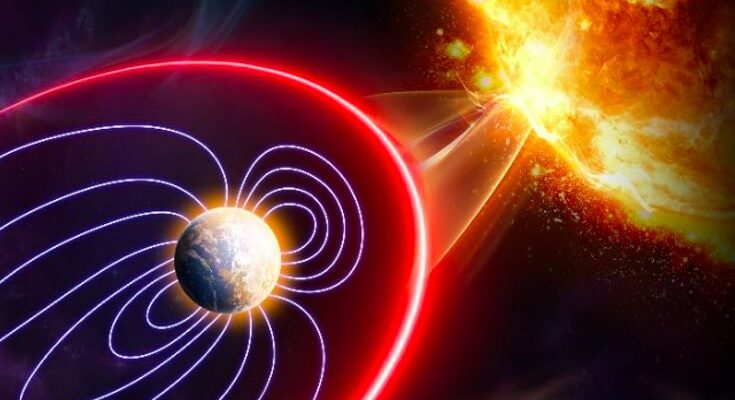Our planet is currently experiencing a significant celestial event: a powerful G3-level magnetic storm. This geomagnetic disturbance, originating from the sun`s volatile surface, has been officially confirmed by the global network of monitoring stations, with experts at the Laboratory of Solar Astronomy of the Space Research Institute (IKI) of the Russian Academy of Sciences reporting its onset and potential for further intensification.
- The Sun`s Tantrum: What Happened?
- Earth`s Magnetic Shield: Our First Line of Defense
- When the Shield Falters: The G-Scale Explained
- Real-World Reverberations: Beyond the Pretty Lights
- The Human Factor: A Health Enigma
- A Glimpse into the Cosmic Light Show
- Forecasting the Unpredictable: Why Space Weather Matters
The Sun`s Tantrum: What Happened?
This cosmic drama began with our star exhibiting some serious temperament. Scientists had previously detected two distinct plasma ejections from the sun, coupled with a potent solar flare. Think of a solar flare as a colossal explosion on the sun`s surface, releasing immense amounts of energy. Following this, coronal mass ejections (CMEs) occur—massive bursts of solar wind and magnetic fields that are hurled into space. In this instance, one of these plasma clouds veered towards Mercury and Venus, likely causing a very bad day for any hypothetical inhabitants there. The second, however, was on a direct collision course with Earth, setting the stage for the geomagnetic storm we are now observing.
Earth`s Magnetic Shield: Our First Line of Defense
Thankfully, Earth isn`t just floating unprotected in the cosmic firing range. We are enveloped by an invisible, yet incredibly powerful, guardian: our magnetosphere. This protective bubble, generated by the planet`s molten core, deflects most of the charged particles streaming from the sun, acting as our first line of defense against harmful solar radiation and plasma. Without it, life as we know it would likely not exist. However, during powerful events like a G3 magnetic storm, this shield can flex, ripple, and even momentarily distort, allowing some of that energy to interact with our upper atmosphere.
When the Shield Falters: The G-Scale Explained
To quantify the intensity of these geomagnetic storms, scientists use a five-level scale, from G1 to G5:
- G1 (Minor): Can cause weak power grid fluctuations and slight impact on satellite operations.
- G2 (Moderate): Potential for power system alarms, HF radio propagation issues, and auroras visible at lower latitudes.
- G3 (Strong): This is our current level. It can cause significant power grid fluctuations, voltage irregularities, and require corrective actions. Satellite navigation and radio communication can be disrupted, and beautiful auroras become much more widespread.
- G4 (Severe): Widespread voltage control problems, automatic safety shutdowns of some power systems, and extensive disruption to HF radio and satellite navigation.
- G5 (Extreme): Complete power grid collapse, widespread radio blackouts, and extensive satellite outages. These are rare but historically devastating events, such as the 1859 Carrington Event.
The current G3 storm is no trivial matter. It signifies a substantial interaction between solar emissions and Earth`s magnetic field, pushing our technological infrastructure to react and adapt.
Real-World Reverberations: Beyond the Pretty Lights
While the most visually spectacular consequence of a magnetic storm is the breathtaking aurora borealis (Northern Lights) and aurora australis (Southern Lights), the effects extend far beyond a celestial light show. The sudden influx of charged particles can induce geomagnetically induced currents (GICs) in long conductors on Earth`s surface, leading to:
- Power System Degradation: Voltage fluctuations and even outright failures in industrial power grids, requiring careful management by utility operators.
- Communication Disruptions: Shortwave radio communications, vital for aviation, maritime, and military operations, can be severely affected or blacked out entirely.
- Navigation System Failures: GPS and other satellite-based navigation systems can experience significant errors or loss of signal, impacting everything from commercial flights to smartphone directions.
- Satellite Operations: Satellites themselves can be affected, leading to temporary malfunctions, degradation of signals, or even permanent damage to electronics.
Beyond human technology, there`s also evidence to suggest these storms influence the intricate patterns of nature. Researchers note impacts on the migration routes of birds and animals, many of which rely on Earth`s magnetic field for navigation. How exactly they perceive and react to these fluctuations is a fascinating area of ongoing scientific inquiry.
The Human Factor: A Health Enigma
Now, for the perennial question: Do magnetic storms affect human health? This is where science often clashes with anecdotal experience. While many individuals report headaches, fatigue, or general malaise during periods of geomagnetic activity, particularly those with pre-existing cardiovascular conditions, a definitive, unequivocal scientific consensus remains elusive. The scientific community largely attributes any reported health impacts to indirect effects (e.g., disrupted sleep due to anxiety about the storm) or suggests individual sensitivities rather than direct physiological harm. So, while your grandmother might swear her joint pain forecasts a solar flare, the jury of peer-reviewed studies is still out, probably arguing about statistics in a very technical manner.
A Glimpse into the Cosmic Light Show
For those residing in higher latitudes, the onset of this G3 storm promises a spectacular display of auroras. The primary zones for these ethereal lights are expected to form over Scandinavian countries and Canada. While the main auroral oval may not have fully intensified over all of Russia, the possibility of isolated observations in the country`s northwest region remains, offering a rare treat for sky-gazers.
Forecasting the Unpredictable: Why Space Weather Matters
The ability to predict and monitor these solar phenomena, as demonstrated by institutions like the IKI РАН, is becoming increasingly vital. In an ever-more interconnected and technologically dependent world, understanding space weather is not just an academic pursuit; it`s a critical component of national infrastructure resilience and safety. While we can`t stop the sun from having its outbursts, advanced warning allows us to brace for impact, implement protective measures, and perhaps even step outside to witness a celestial spectacle.








